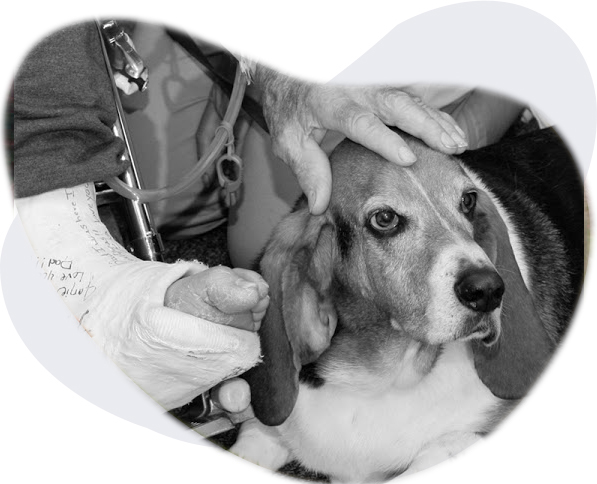
Kusek
JOYCE KUSEK of Ashton enjoys her snuggle with Coulee owned by Marla Bouton. Bouton, a volunteer in the pet therapy program, co-owns Hilltop Pet Clinic and leads a group of volunteers from the clinic in the Good Sam program.
KEARNEY — Coulee laid on Joyce Kusek’s bed at CHI Health Good Samaritan, closed her eyes and listened to Kusek’s soothing voice. With a soft smile, her hand stroking Coulee, Kusek told Coulee about the four dogs she has back home in Ashton.
Later that afternoon, Coulee curled up near the pillow of an elderly patient whose voice purred as she related stories about the dogs she had long ago.
Coulee, who belongs to Marla Bouton, is one of the 36 dogs in the Animal Assisted Therapy Program at Good Sam. Founded in 1993, it allows approved volunteers to bring their dogs and cats to visit patients. The 21-year program is thriving like a bouncy puppy.
“It used to be that bringing patients’ pets up to their rooms was a bit of an adventure. We had to sneak them in,” said Bouton, a co-owner of Hilltop Pet Clinic at 4507 First Ave. Place.
These stories and more are chronicled in a new book, “Silent Conversations.” Put together by hospital staff and volunteers and published by the Good Samaritan Hospital Foundation, it tells about the magic and smiles that animals freely bring to patients inside sterile hospital rooms.
KEARNEY — Coulee laid on Joyce Kusek’s bed at CHI Health Good Samaritan, closed her eyes and listened to Kusek’s soothing voice. With a soft smile, her hand stroking Coulee, Kusek told Coulee about the four dogs she has back home in Ashton.
Later that afternoon, Coulee curled up near the pillow of an elderly patient whose voice purred as she related stories about the dogs she had long ago.
Coulee, who belongs to Marla Bouton, is one of the 36 dogs in the Animal Assisted Therapy Program at Good Sam. Founded in 1993, it allows approved volunteers to bring their dogs and cats to visit patients. The 21-year program is thriving like a bouncy puppy.
“It used to be that bringing patients’ pets up to their rooms was a bit of an adventure. We had to sneak them in,” said Bouton, a co-owner of Hilltop Pet Clinic at 4507 First Ave. Place.
These stories and more are chronicled in a new book, “Silent Conversations.” Put together by hospital staff and volunteers and published by the Good Samaritan Hospital Foundation, it tells about the magic and smiles that animals freely bring to patients inside sterile hospital rooms.


